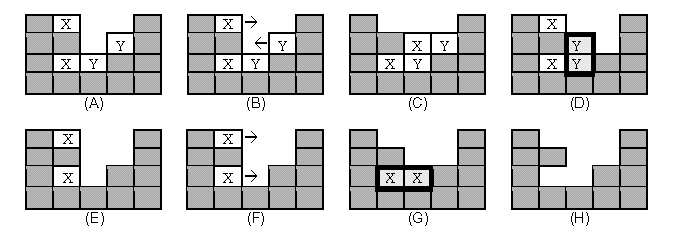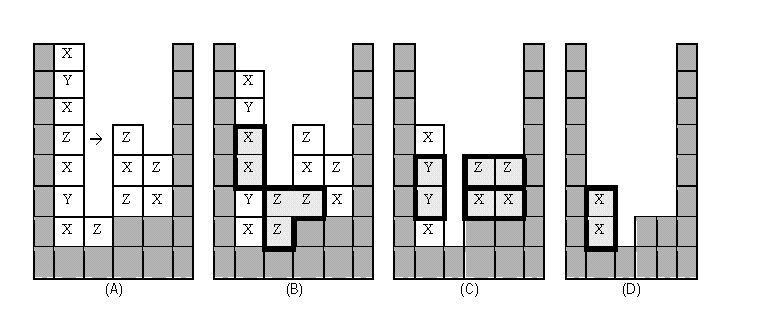
1. Read chapter 1 in the book.
2. Learn Python
Go to http://www.python.org to find out information about Python and read its short tutorial. Mess around with the language by writing a few short programs and playing with the interpreter. Then, use Python to solve the following problem from the recent ACM programming contest (which has no direct relevance to compilers other than being a good way to learn a new language):
The game Vexed is a Tetris-like game created by James McCombe. The game consists of a board and blocks that are arranged in stacks. If the space to the immediate left or right of a block is open (this is, it contains no other blocks nor any part of the game board "wall"), then that block can be moved in that direction. Only blocks that are not part of the game board wall can be moved; "wall" blocks are stationary in all events. After a block is moved, if it or any other block no longer has anything under it, those blocks fall until they land on another block. After all of the blocks have landed, if any two or more identically marked pieces are in contact horizontally and/or vertically, then those blocks are removed as a group. If multiple groups result, then all groups are removed simultaneously. After all such groups are removed, all blocks again fall to resting positions (again, wall blocks do not move). This might then result in more groups be removed, more blocks falling, and so on, until a stable state is reached.
Consider the simple example shown here. For reference purposes, number the rows of the board from the top to bottom starting with an index value of zero, and number the columns from left to right, also with a starting index value of zero. Board positions can therefore be referenced as ordered (row,column) pairs. By additionally using an "L" or "R" to refer to a left or right push respectively, we can also use the ordered triple (row, column, direction) to indicate moves.

There are often many ways to solved a particular Vexed puzzle. For this problem, only solutions with a minimum number of moves are of interest. The minimum number of moves can sometimes be surprising. Consider another example:

In this example, there are ten possible first moves, and there are in fact several ways to arrive at a solution. There is only one move in (A), however that allows us to achieve a solution with the minimum number of moves. Obvserve the sequence of events shown if (3,1,R) is chosen as the first move.
Input
The input will consist of several puzzles. Each begins with a line containing integers giving the number of rows (NR) and columns (NC) in the puzzle, and a string of characters (terminated by newlines) giving the name of the puzzle; these items are separated by one or more spaces. This line is followed by an NR by NC array of characters defining the puzzle itself; and end of line will follow the last character in each row. NR and NC will each be no larger than 9. The "outer walls" (in addition to "inner wall" blocks) on the left, right, and bottom will always be included as part of the puzzle input, and are represented as hash mark (#) characters. Movable blocks are represented by capital letters which indicate the marking on the block. To avoid possible amiguities, open spaces in the puzzle are represented in the input by a hyphen (-) rather than by spaces. Other than the outer walls, wall blocks and moveable blocks may be arranged in any stable pattern.
A puzzle with zero dimensions marks the end of the input and should not be processed.
Output
For each input puzzle, display a minimum length solution formatted as shown in the sample output. In the event that there are multiple solutions of minimum length, display one of them.
Sample Input
4 5 SAMPLE-01 #A--# ##-B# #AB## ##### 6 7 SAMPLE-02 #--Y--# #-ZX-X# #-##-## #-XZ--# ####YZ# ####### 0 0 ENDSample output
SAMPLE-01: Minimum solution length = 2 (B,1,3,L) (A,0,1,R) SAMPLE-02: Minimum solution length = 9 (Y,0,3,R) (Z,4,5,L) (X,1,3,R) (Z,1,2,R) (Z,1,3,R) (X,3,4,R) (X,3,2,R) (X,4,5,L) (X,1,5,L)
Handin procedures
% python vexed.py puzzle1
The input data should be read from the supplied file and minimum puzzle solutions should be produced as output.
% tar -cf yourlogin.tar vexed.py README
% cp yourlogin.tar /stage/classes/current/CS326/handin/assign1